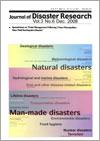Citation:

Abstract:
A project titled “Establishing the advanced disaster reduction management system by fusion of real-time disaster simulation and big data assimilation,” was launched as Core Research for Evolutional Science and Technology (CREST) by the Japan Science and Technology Agency (JST). Intended to save as many lives as possible in future national crises involving earthquake and tsunami disasters, the project works on a disaster mitigation system of the big data era, based on cooperation of large-scale, high-resolution, real-time numerical simulations and assimilation of real-time observation data. The world’s most advanced specialists in disaster simulation, disaster management, mathematical science, and information science work together to create the world’s first analysis platform for real-time simulation and big data that effectively processes, analyzes, and assimilates data obtained through various observations. Based on quantitative data, the platform designs proactive measures and supports disaster operations immediately after disaster occurrence. The project was launched in 2014 and is working on the following issues at present.
Sophistication and fusion of simulations and damage prediction models using observational big data: Development of a real-time simulation core system that predicts the time evolution of disaster effect by assimilating of location information, fire information, and building collapse information which are obtained from mobile terminals, satellite images, aerial images, and other new observation data in addition to sensing data obtained by the undersea high-density seismic observation network.
Latent structure analysis and major disaster scenario creation based on a huge amount of simulation results: Development of an analysis and extraction method for the latent structure of a huge amount of disaster scenarios generated by simulation, and creation of severe scenarios with minimum “unexpectedness” by controlling disaster scenario explosion (an explosive increase in the number of predicted scenarios).
Establishment of an earthquake and tsunami disaster mitigation big data analysis platform: Development of an earthquake and tsunami disaster mitigation big data analysis platform that realizes analyses of a huge number of disaster scenarios and increases in speed of data assimilation, and clarifies the requirements for operation of the platform as a disaster mitigation system.
The project was launched in 2014 as a 5-year project. It consists of element technology development and system fusion, feasibility study as a next-generation disaster mitigation system (validation with/without introduction of the developed real-time simulation and big data analysis platform) in the affected areas of the Great East Japan Earthquake, and test operations in affected areas of the Tokyo metropolitan earthquake and the Nankai Trough earthquake.

